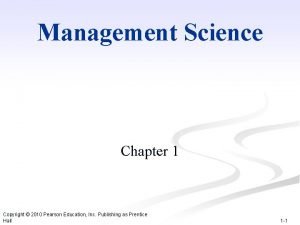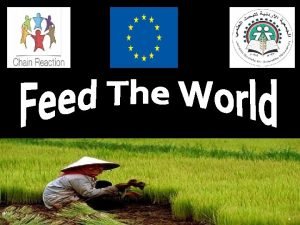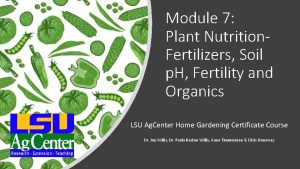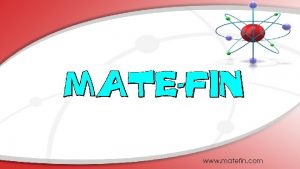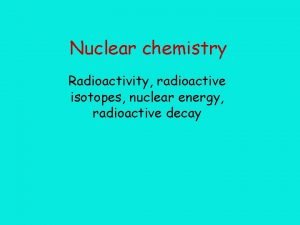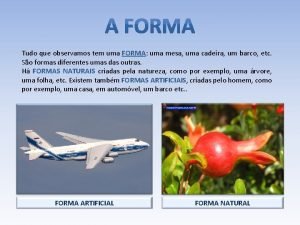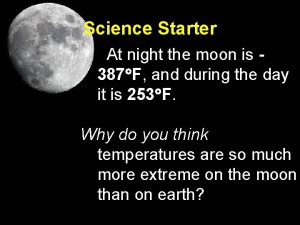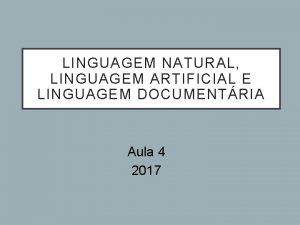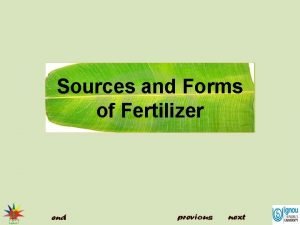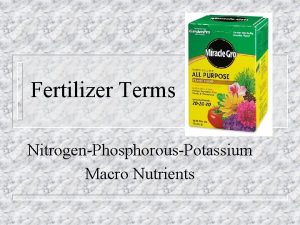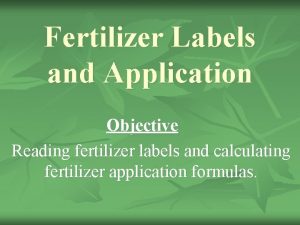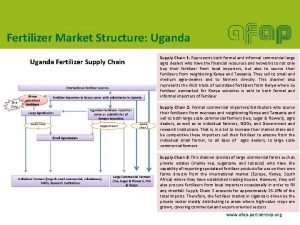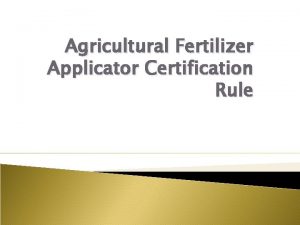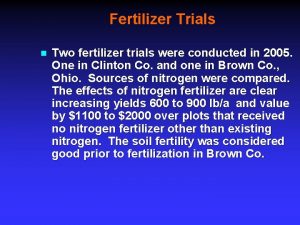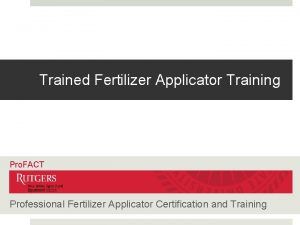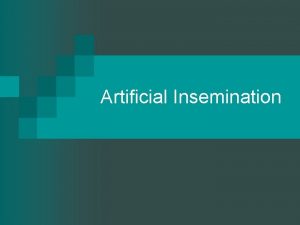1 The Definition of Fertilizer Natural or artificial
























- Slides: 24

1

The Definition of Fertilizer � Natural or artificial substance containing chemical elements that improve growth and productivity of plants. � Modern chemical fertilizers include one or more of the three elements most important in plant nutrition: Nitrogen, Phosphorus, and Potassium. � The second important Nutrients are : Sulfur, Magnesium, and Calcium. 2

Why Plants need Fertilizer? Plants depend on nutrients in the soil to provide the basic chemicals for these metabolic reactions. • The use of synthetic fertilizers has significantly improved the quality and quantity of the food available today. • 3

The Nitrogen Cycle 4

Discovered Nitrogen fertilizer The Haber Process: 1)Combines Nitrogen from the air with Hydrogen derived mainly from natural gas (Methane)into Ammonia. 2)The reaction is reversible. 3) The production of Ammonia is exothermic. 5

The Benefits of Nitrogen fertilizer �The primary components in fertilizers are nutrients which are vital for plant growth. �Nitrates are known to be essential components for making protein in plants. �Plants use Nitrogen in the synthesis of proteins, nucleic acids. 6

Negative effects of Nitrogen fertilizer � Nitrogen at higher levels causes a loss of certain plant species, depletion of soil nutrients, death of fish and aquatic organisms, and contamination of drinking water. � When plants are nitrogen deficient, they are marked by reduced growth and yellowing of leaves. 7

Types of Nitrogen ferttilizer Urea contains 45% to 46% Nitrogen. Urea is a solid that is granulated before applying. 2. Anhydrous ammonia, which contains 82% nitrogen it is one of the most commonly used Nitrogen fertilizers because it has a higher concentration of Nitrate and is lower in cost. 1. Urea 8

Types of Nitrogen ferttilizer 3 - Ammonium nitrate contains 34% nitrogen. It is a 50 -50 mix of Ammonium and Nitrate Nitrogen. 4 - Ammonium Sulfate contains only 21% Nitrogen. It is applied as a dry form with no Nitrogen loss through volatilization. 9

The Problem! What is the best amount of Nitrogen fertilizer we can add to plants? 10

Hypothesis Not all amount of Nitrogen fertilizer is suitable for plants. 11

Methodology 1 -Prepare the pots, fill it with the same soil weight(738)gram. 12

Methodology 2 -Seven Pea Seeds were planted in each pot, For 12 Days and irrigated as needed. 13

Methodology 3 -Six treatments were Done , Nitrogen fertilizer were added in different weight (0, 2, 3, 4, 5, 6)g. 14

Methodology 4 - Nitrogen fertilizer was dissolved in 100 ml of distilled water. 15

Methodology 5 - Nitrogen fertilizer solutions were added to the Soil. 16

Methodology 6 -The Treatments were made in triplicate. 17

Methodology 7 -Observe and record the growth of plants per day with the addition of water in equal amount. Click here to see Click the video me! 18

Methodology 8 -Measure and record the length of the Stalk Average Length of stalk in (cm) date 6 g 5 g 4 g 3 g 2 g 0 g 0 0 0 15/4 0 0 0. 9 17/4 0 0 0. 7 0. 5 0 1 18/4 0 0 1. 75 0. 96 0. 5 1. 36 19/4 0 0 2. 73 1. 63 1 2. 13 20/4 0 0 5. 13 3. 22 2. 2 4. 4 22/4 0 0 6. 4 5. 28 2. 7 5. 11 24/4 0 0 8 6. 88 4 5. 74 27/4 19

Results 9 Length of the stalk in cm 8 7 6 0 g 5 2 g 4 3 g 4 g 3 5 g 2 6 g 1 0 0 5 10 15 20 25 30 DATE 20

Notes 1 -The beginning of the growth in pots that does not contain fertilizer. 2 -The growth of plants in all pots variably. 3 -Observed the quality of each of the stalk length and diameter , surface area of the leaves and the number of branches in the pots which contain (4 g/100 ml). 4 -Did notice the growth in pots which contain(5 g), (6 g) nitrogen fertilizer. 21

Conclusion Nitrogen fertilizer should be added to the soil in a certain amount, taking into account: 1 - Type of plant. 2 -Soil conditions. 3 -Type of fertilizer. 22

Recommendations Based of the results of the research, we recommended the farmers to: 1 - Use the right percentage of Nitrogen fertilizer. 2 -Use the suitable Nitrogen fertilizer to suit the type of plants , and the nature of the soil. 3 -Further research need, Find ways to reduce the impact of nitrogen fertilizer on groundwater. 23

References Books 1 -Rao, N. S. Biofertilizers in Agriculture & Forestry. IBH, 1993. 2 -Stocchi, E. Industrial Chemistry. Ellis Horwood, 1990. Lowrison, George. Fertilizer Technology. John Wiley and Sons, 1989. Periodicals Kirschner, Elisabeth. "Fertilizer Makers Gear up to Grow. " Chemical & Engineering News, March, 31 1997, p. 13 -15. [Article by: Perry Romanowski] 24
 Evergreen fertilizer company produces fertilizer
Evergreen fertilizer company produces fertilizer Artificial fertilizer meaning
Artificial fertilizer meaning Plant nutrition and soil science
Plant nutrition and soil science Nitrogen in plants is needed for
Nitrogen in plants is needed for Natural and artificial radioactivity
Natural and artificial radioactivity Natural transmutation example
Natural transmutation example Artificial selection vs natural selection
Artificial selection vs natural selection Natural and artificial radioactivity
Natural and artificial radioactivity Natural selection vs artificial selection
Natural selection vs artificial selection Difference between continuous and discontinuous variation
Difference between continuous and discontinuous variation Example of disruptive selection
Example of disruptive selection Natural selection vs artificial selection
Natural selection vs artificial selection Compensating curves
Compensating curves Natural vs artificial radioactivity
Natural vs artificial radioactivity Natural and artificial food additives
Natural and artificial food additives Estruturas naturais e artificiais
Estruturas naturais e artificiais Mental set
Mental set Types of natural light
Types of natural light Mapa conceptual de la luz
Mapa conceptual de la luz Difference between natural and artificial greenhouse
Difference between natural and artificial greenhouse Linguagem artificial
Linguagem artificial Natural hazards vs natural disasters
Natural hazards vs natural disasters Natural capital and natural income
Natural capital and natural income Multi k prills
Multi k prills Form of fertilizer
Form of fertilizer
